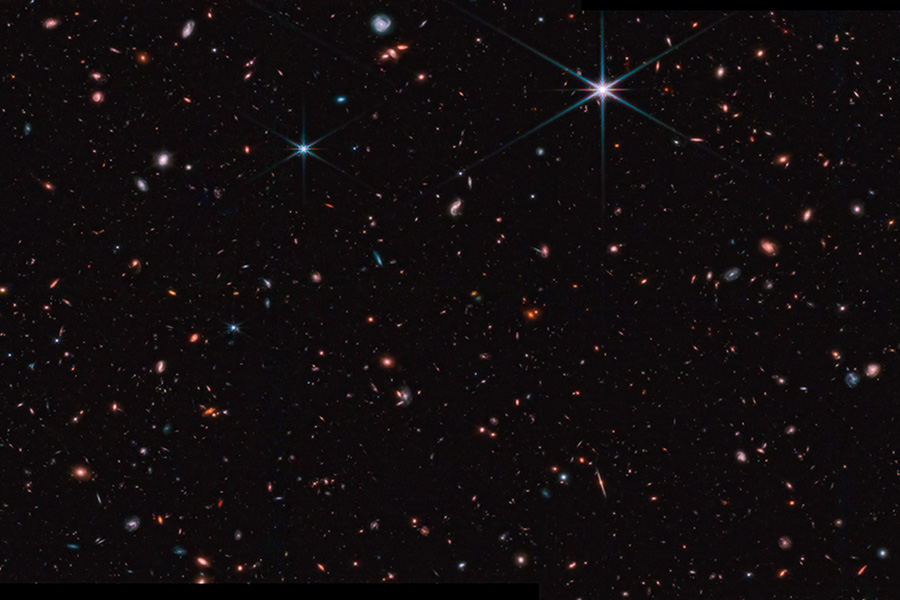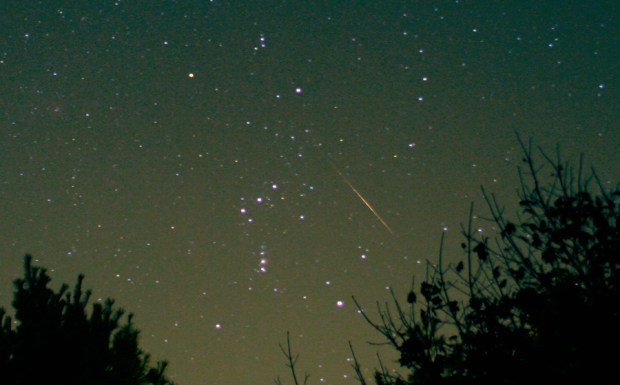NASA / STScI / CEERS / TACC / S. Finkelstein / M. Bagley / R. Larson / Z. Levay
Little red dots: That’s how astronomers describe some of the distant galaxies in James Webb Space Telescope images. Small though they are, once these ruby-colored smudges attracted notice, they became impossible to overlook.
They are compact galaxies that existed several hundred million years after the Big Bang, when the universe was still in its infancy. They would actually appear quite red to our eyes even if we could travel back in time to see them up close. The source of these galaxies’ red light, though, has remained something of a mystery. New research published in the Astrophysical Journal Letters tries to settle that question.

B. Wang / Astrophysical Journal Letters 2024
Initial analyses of these red early galaxies found that they must host vast quantities of old stars. While very massive stars tend to be bluer in color, they explode in supernovae soon after their birth; lower-mass stars, which are redder, last longer. But, given the limited time to form stars in such quantity, other astronomers have suggested alternatives. For example, if a galaxy were to host a feeding black hole at its center, still enshrouded in dusty gas, that could explain rose-tinted light without needing quite so many stars.
When Bingjie Wang (Penn State) and her collaborators explored three of these “little red dot” galaxies in detail, they found that the source for at least some of those red wavelengths is indeed a surprisingly old population of stars. Based on this new analysis, these galaxies were churning out stars by the dozen when the universe was only 500 million years old.
Rubies in the Rough
The galactic trio represent an intriguing selection out of thousands of galaxies that the James Webb Space Telescope (JWST) saw in early observations, and which scientists with the RUBIES survey are now targeting for follow-up. The team is collecting a spectrum for each galaxy with JWST’s Near-infrared Spectrograph, as well as archival observations from the Hubble Space Telescope.
Of the thousands being surveyed, three showed a strong feature in their spectra called the Balmer break. If the galaxies’ light is coming from stars, then their Balmer breaks probably come from the atmospheres of stars more than 100 million years old. The presence of the feature doesn’t tell astronomers how many old stars there are, though. And Wang’s team also finds that the spectra of two of the three galaxies show gas whirling around a supermassive black hole. Just how massive those black holes are is likewise uncertain: The black holes could hold anywhere from millions to hundreds of millons of Suns’ worth.
The astronomers tried to understand the origin of the galaxies’ light using three options: one in which the central black hole contributes little and most of the light comes from an unexpectedly huge population of old stars, one in which the central black hole contributes most of the light and only a few older stars are necessary, and one middle-of-the-road option in which both old stars and a feeding black hole contribute to the galaxies’ overall appearance.
The first of these options suggests unexpected bursts of starbirth early in cosmic history. In the second and third options, it’s the central black hole that ends up more massive than expected for such small galaxies. “None of these models fully align with our current understanding of galaxy formation and evolution,” the team notes in their conclusions.
Deeper and Redder
“This paper is particularly excellent, in my opinion, because it takes a considered and careful look at the data to test a range of possibilities, rather than pushing just one version of the narrative,” says Adam Carnall (Royal Observatory Edinburgh, UK), who wasn’t involved in the study.
“It certainly seems likely,” he adds, “given a whole host different of results from JWST, that galaxies were starting to form earlier and in greater numbers than we previously thought.” But he cautions, “until we have more data it’s hard to be sure how bad the problem is.”
Wang and her colleagues agree: “Future deeper and redder observations are critical,” they write. While this study showcases near-infrared data from JWST, long mid-infrared exposures with the same telescope could help discern the nature of these little red dots.




